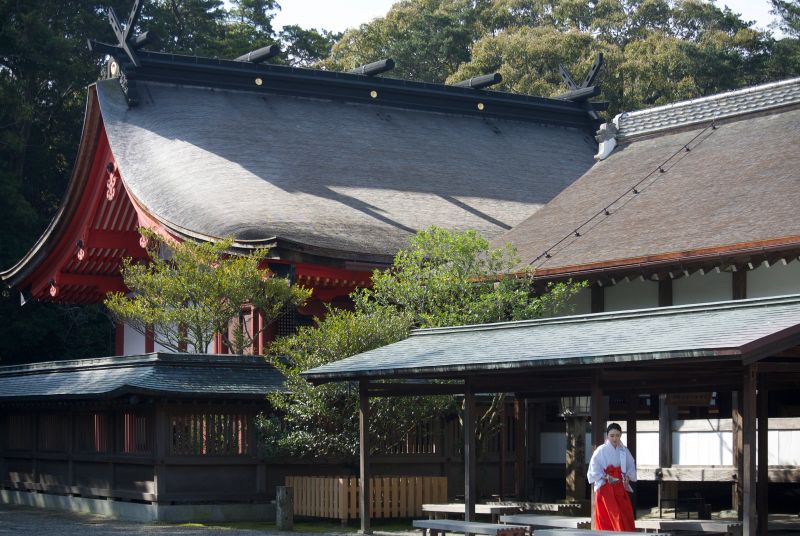
The Honden (Sanctuary) and Haiden (Worship Hall) at Hetsu-miya, the most accessible part of the Munakata World Heritage site. In the early morning the miko are busy cleaning and sweeping the whole premises.
World Heritage Shinto shrines
In 2012 for a Tuttle book, published two years later as Japan’s World Heritage Sites, I travelled the length of Japan visiting all of the Unesco sites. Along the way I was intrigued by the number of Shinto shrines involved. These were often minor shrines and little known, so it was a surprise to find them listed as part of a Unesco World Heritage site. Accordingly I started to make a personal listing of them in order of significance, dividing them at first into three separate ranks.
The first rank are shrines created as a World Heritage site in their own right, the prime example being the wonderful Itsukushima Shrine at Hiroshima. The second rank comprises shrines nominated as part of a larger entity, for example Kamigamo, Shimogamo and Ujigami Shrines which are all components of the Ancient Kyoto World Heritage site.
The third rank happen to stand on a site that is nominated for other reasons. Hashima Shrine on Gunkanjima is a good example, for it is incidental to the island’s reason for being nominated as part of the Meiji Industrial Revolution World Heritage site. (For an overview of World Heritage shrines, please click here.)
Munakata Taisha
In 2017 a Shinto shrine received recognition from Unesco under its own name, placing it in the prestigious front rank of Japan’s World Heritage shrines. Munakata Taisha, comprising four component parts, is in Fukuoka Prefecture, Kyushu, and owes its status to the tiny uninhabited island of Okinoshima. In ancient times the island hosted the last shrine for Japanese setting off on the perilous voyage to Korea. It was therefore a place to make offerings to the Kami in the hope of a safe crossing. As a result the island has proved in recent times to be the site of a staggering 120,000 rare and precious objects.
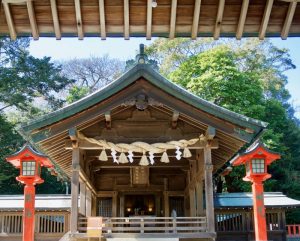
The Nakatsu-miya Worship Hall
Later two other shrines were put up in connection with the island shrine. One of them was on Kyushu proper near the Fukuoka coast, called Hetsu-miya Shrine. The other was on the offshore island of Oshima. This is known as Nakatsu-miya Shrine.
Together with the original island shrine on Okinoshima, the three shrines comprise the tripartite complex of Munakata Taisha. The shrine was prestigious, because of its significance in continental trading between the fourth and ninth centuries. Political uncertainty on the continent meant that trade diminished thereafter, lessening the power of the Munakata clan, whose burial mounds near Hetsu-miya shrine are also part of the Unesco site.
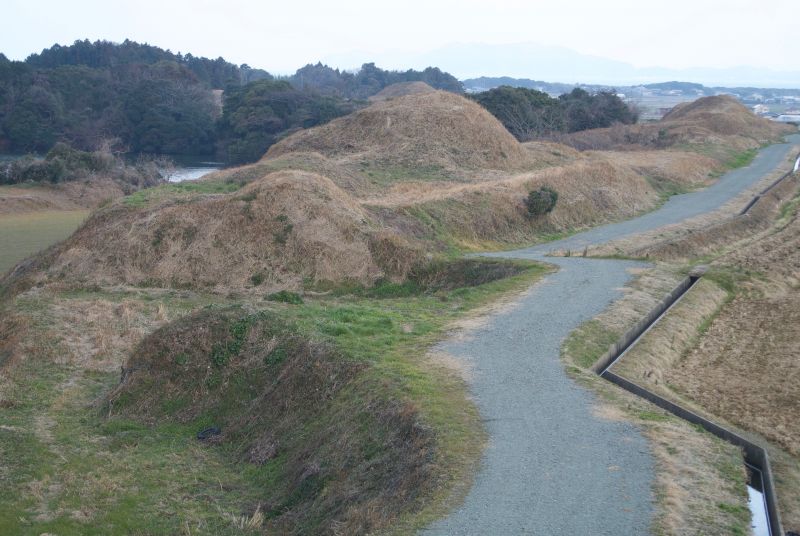
Burial mounds of the powerful Munakata clan, who oversaw the sealanes between north Kyushu and Korea
Hetsu-miya Shrine
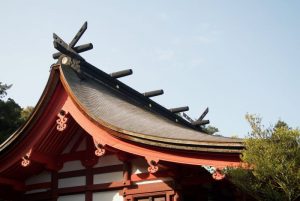 The main shrine, commonly referred to as Munakata Taisha but officially the Hetsu-miya (or Hetsu-gu) shrine, is about forty minutes outside Fukuoka. It’s the biggest and most accessible part of the World Heritage site. The buildings were put up around the twelfth century, though there’s a fascinating clearing where it’s thought rituals were originally held. For those of us into nature worship, there’s a real sense here of drawing down spirits in the woods. These simple outdoor sites of worship were commonplace, before the arrival of Buddhism introduced the idea of providing shelter for the deities in a ‘palace’ of their own.
The main shrine, commonly referred to as Munakata Taisha but officially the Hetsu-miya (or Hetsu-gu) shrine, is about forty minutes outside Fukuoka. It’s the biggest and most accessible part of the World Heritage site. The buildings were put up around the twelfth century, though there’s a fascinating clearing where it’s thought rituals were originally held. For those of us into nature worship, there’s a real sense here of drawing down spirits in the woods. These simple outdoor sites of worship were commonplace, before the arrival of Buddhism introduced the idea of providing shelter for the deities in a ‘palace’ of their own.
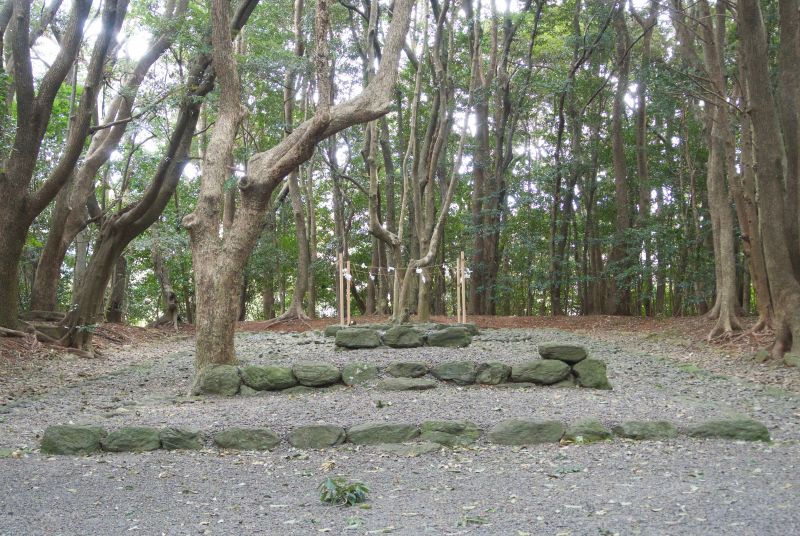
The clearing in the woods behind the main shrine where worship was originally held
As well as the main shrine there are two immaculate auxiliary shrines, one for each of the three Munakata sisters, who are the presiding deities. In Japanese myth the women who were daughters of the sun goddess Amaterasu were known as Michinushi-no-Muchi, meaning those who control traffic safety, and sealanes in particular. In this way the female deities became popular with sailors and fishermen, who prayed to them for good catches as well as safety at sea.
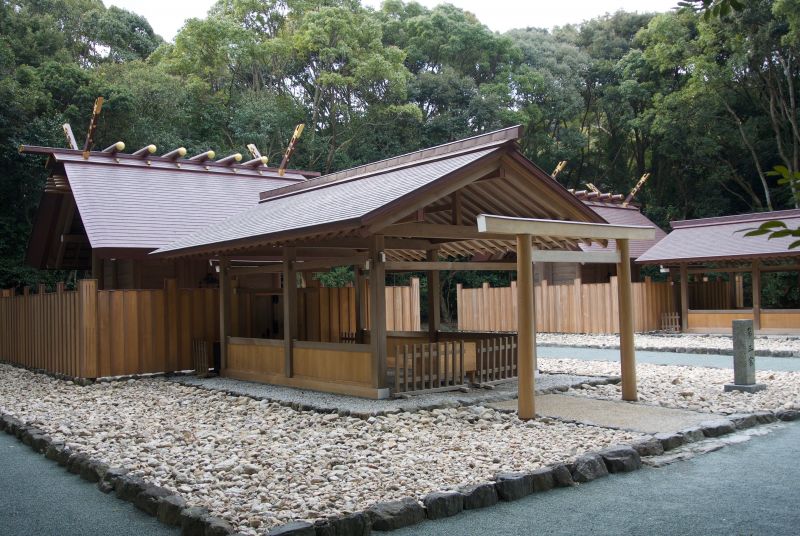
The Second and Third Shrines at Hetsu-miya are structures sent from Ise Jingu which are taken down in the 20-year rebuilding cycle known as Shikinen Sengu.
Also in the precincts of Hetsu-miya is a treasure house displaying many of the rare artefacts unearthed on the Okinoshima island. These include jewellery, glasswork, horse equipment, mirrors, swords and some items that originate along the Silk Road, from as far afield as Persia.
Nakatsu-miya Shrine
From Hetsu-miya a nearby ferry port provides a twenty-minute passage to Oshima Island, on which stands Nakatsu-miya shrine. It is located on a steep slope overlooking the harbour, and featuring a long stone staircase.
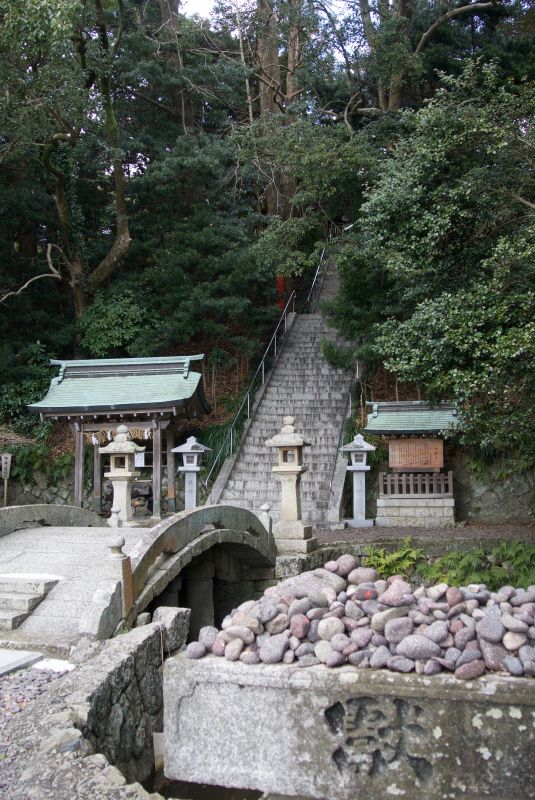
Nakatsu-miya shrine overlooking Oshima port is an outlying branch of Munakata Taisha, acting as a bridge between the main shrine on Kyushu and the distant island of Okinoshima.
The shrine buildings were only put up in the sixteenth century, and originally rituals were held in the open on the top of Mount Mitake. A path behind the shrine leads up to the summit, meaning that the Munakata complex as a whole is a fascinating place to explore the kind of nature worship that once held sway in Japan.
One of the interesting features of Nakatsu-miya is the Distant Worship Place that stands on the other side of the island, a pleasant thirty minute walk away. The outlying subshrine is set on a cliff facing the sacred island of Okinoshima. Since ordinary people were not allowed to set foot on the island, this was as close as they could get. These distant worship places, known as Yohaisho, are not uncommon in Japan and usually focus on Ise Jingu, providing a means of offering prayer for those unable to travel there in person (for a posting about the one in Kyoto, please see here).
There used to be an annual festival on Okinoshima, when over a hundred local men were allowed onto the island after purifying themselves in the sea. Now with World Heritage recognition, even this has been suspended, and the only person allowed on the sacred island is the Shinto priest who conducts rituals for the kami. You don’t get much more special than that! Though access to the treasure island is banned, it is definitely worth making the pilgrimage to the Distant Viewing Place pictured below, which even on an overcast day still offers an imaginative view into the fascinating history of Japan’s ancient past.
**************
Reference
Shinto Shrines by Joseph Cali and John Dougill (Uni of Hawaii Press), p.274
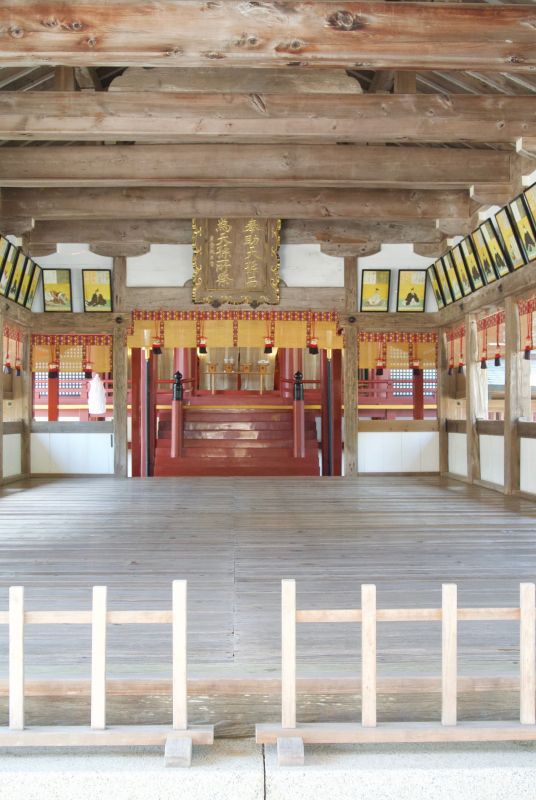
Looking into the Haiden of the Hetsu-miya, main shrine of the Munakata Taisha complex
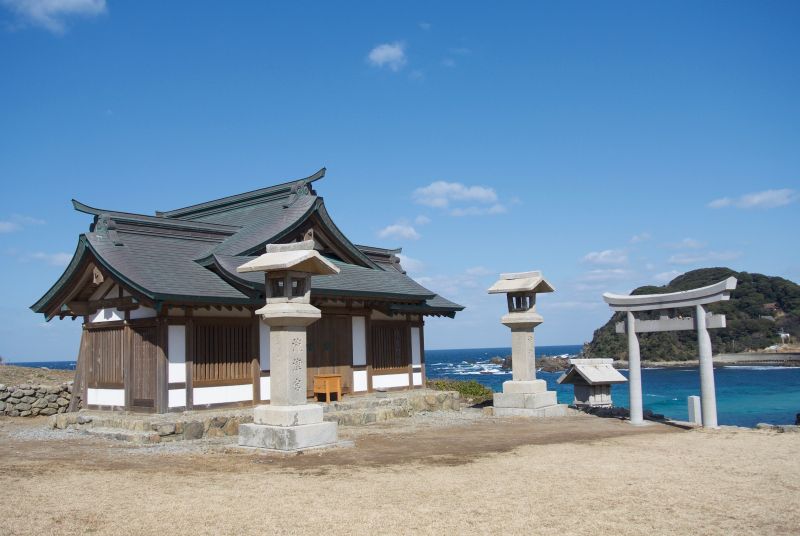
The Yohaisho, Distant Worship Shrine for Okinoshima 35 miles away, stands on its own on a small cliff edge, looking wistfully out to sea and the small sacred island barely visible on the horizon

Could not even wish to read something better than this.
חשפניות בצפון